| Content |
Update: Metz 52 AF-1 replaces Metz 50 AF-1 (comparison review)
Update: Metz 48 AF-1 is being replaced by Metz 50 AF-1
Update: Metz has released firmware updates for 48 AF-1 and 58 AF-1 units
Metz Mecablitz 48 AF-1 flash is built very well. It has swivel and tilt head, reflector card, and wide-angle diffuser. Being a little brother of Metz 58 AF-1 flash unit, Metz 48 AF-1 inherits a lot of its features: second curtain synchronization, high speed sync, wireless slave mode, etc. The unit is fully TTL compatible, and it allows doing things manually as well. It is going to ease your future firmware upgrades with the USB port connection. The only flaw is the tilting lock, which may not be suitable for some applications.
| Guide number (ISO 100, lens 105 mm): | 48 m (157 ft) |
| Modes: | TTL, TTL-HSS, Manual, Manual-HSS |
| Manual partial light output: | 1/1 ... 1/128 light output in 1/3 increment |
| Recycling time (at full light output): | about 3.5 seconds |
| Light coverage with the main reflector: | from 24 mm (35 mm format) |
| Light coverage with the wide-angle diffuser: | from 18 mm (35 mm format) |
| Wireless capabilities: | Slave |
| Second curtain synchronization: | Yes |
| Modeling light: | Yes |
| Flash bracketing: | Yes |
The Metz 48 AF-1 flashgun has an excellent build quality. It is a very nice looking piece of equipment, and it doesn't feel cheap despite the fair price (currently around $220). It is compact, which can be considered as a plus, and it proudly wears "Made in Germany" sign right above the LCD display.
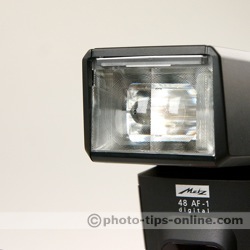 |
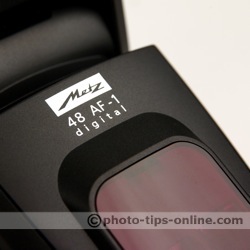 |
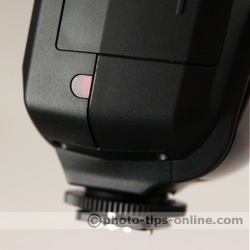 |
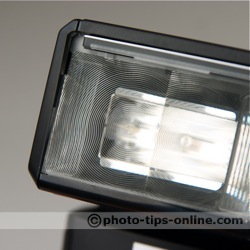 |
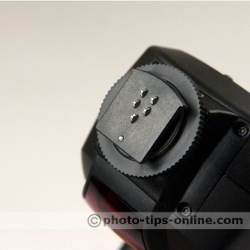 |
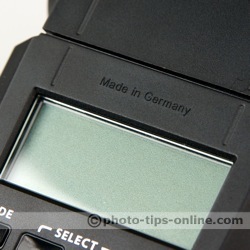 |
The unit has swivel and tilt head, which goes 120 degrees clockwise and 180 degrees counter-clockwise. It tilts within the usual range of -7 to +90 degrees. There is only one button to be pushed to adjust the head position which superior in comparison to the older two-button designs.
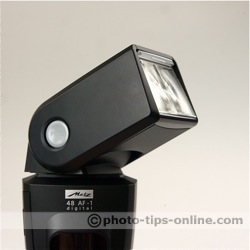 |
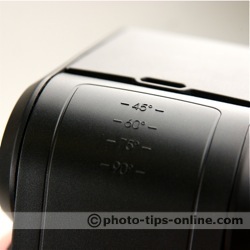 |
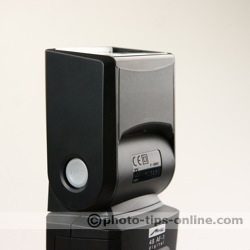 |
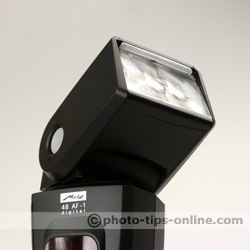 |
The Metz 48 AF-1 flashgun has a built-in wide-angle diffuser and a white reflector card. The white reflector card cannot be pulled out alone. At first, you have to pull the diffuser that will pull the card. Then, you have to push the diffuser back in. We don't really like this, but it is a typical design (see Canon 580EX II review, for example), and is not a real issue. Also, pulling the diffuser out feels a bit clumsy. It does not give that "solid" feel that we get from the rest of the unit.
 |
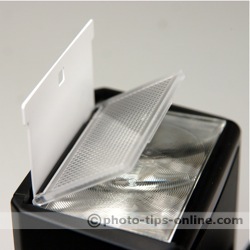 |
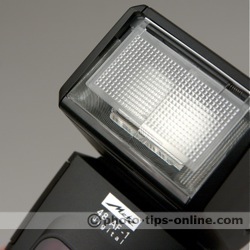 |
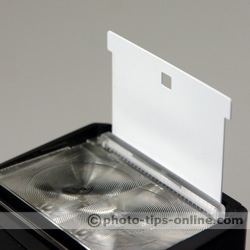 |
The buttons on the unit have very nice tactile feeling. They are neither too small nor too big - they are just right. There are only four of them to fully control the unit. The downside of it is that to select something on the display you need to press two buttons. The idea behind this choice of interface is probably the prevention of an accidental change of settings, which may easily happen when only one button is to be pushed. The price for that is the necessity to use two fingers (and probably two hands) to change the settings. So, this approach has the right to live, and it's up to each user to decide whether it is acceptable or not.
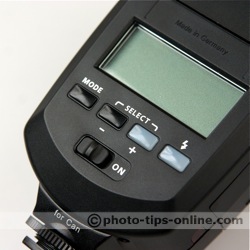 |
The LCD display is pretty neat. Some of the symbols, however, are too small and hard to read. The display lights up every time you press any button. There is no dedicated "illuminate display" button. It seems as a good idea since it saves one additional push of a button and is unlikely to consume too much of the battery life.
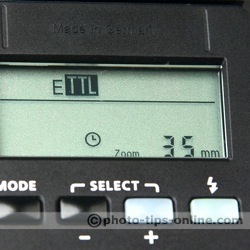 |
One of the cool features of Metz 48 AF-1 flashgun is the ability to upgrade the firmware via USB port. There is no need anymore to send the flash away when an upgrade has to be done. Even though the firmware updates do not happen too often, it is very convenient to have a USB connectivity and be able to do the upgrades quickly.
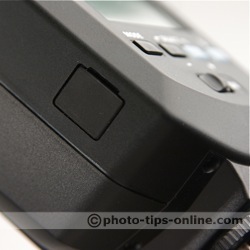 |
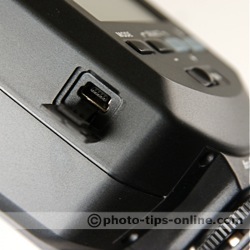 |
The battery compartment door is well built. It opens without any difficulty and closes tight. Obviously,the contacts polarity is marked, but there is no picture to show how the batteries should go (There is no space for it). This is a very little detail, but having an illustration would be more useful.
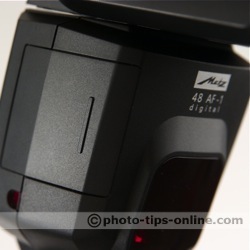 |
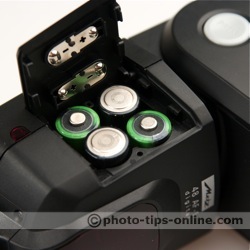 |
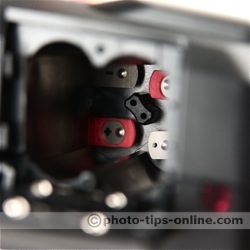 |
The performance of the Metz 48 AF-1 flash is impressive. Although we did not test the unit in all possible ways, the few shots we took demonstrate good exposure handling - the E-TTL at work.
The flash makes no noise during recycling. Head motor produces some buzzing, but it's nothing to be annoyed by.
The recycling time is only 3.5 seconds at full power, which gives a better chance not to miss another precious moment while your flash is getting ready. For some reason, some web-sites say that this flash requires 5 seconds to recycle. The manual we have says 3.5 seconds. To verify which number is correct, we did a quick check. To our satisfaction, the unit recharges in about 3.5 seconds after firing at full power.
In dim light conditions, auto focus assist beam did help. We, however, expected a bit better performance.
If your camera can communicate with flash units about the size of its image sensor, these units will understand this information and adjust the light output accordingly. This is helpful unless you have a top-of-the-line DSLR with a full-frame sensor.
One issue that we discovered with this flashgun is the locking of the head when it's tilted. The lock is kind of weak. Don't get us wrong here, it's strong more than enough to keep the flash head in place, but if you attach a big diffuser, the head won't be able to hold it. An omni-bounce or a bounce card is not a problem. However, if you use something as big as Gary Fong WhaleTail, there is no way the flash head is going to hold up. So, when shopping for a flash diffuser consider the weight factor. (You may want to read our Best Flash Diffuser review for more information about flash light modifiers.)
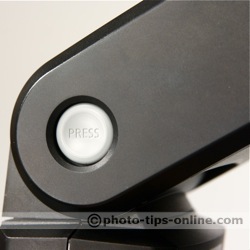 |
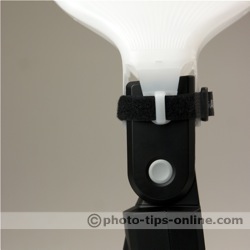 |
One minor thing that caught our attention is the inscription right above the knurled nut. It says "for Can". Our unit is the "C" model designed for the Canon cameras, so, obviously, "Can" stands for "Canon". Why isn't the whole word "Canon" printed on the unit? There is plenty of space. Of course it affects nothing, but looks a bit ugly to us. Well... we are sure they had their reasons (trademark issues or something like that).
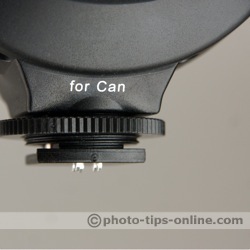 |
Also, we have to mention that there is no pouch included with the flash. Off camera shoe stand is not included, as well. All you get is the flash itself and the manual (for the units they sell in the United States).
Finally, let us note that currently Metz makes 48 AF-1 for Canon E-TTL II, Nikon i-TTL, Pentax & Samsung SLR Cameras, Sony Alpha Series (former Konica Minolta SLRs), and Olympus & Panasonic SLR Cameras. Thus, Mecablitz 48 AF-1 can be a great alternative to units like Nikon SB-600 or Canon 430EX II, for example.
Metz Mecablitz 48 AF-1 digital is a powerful flashgun with a lot of settings. It produces well exposed shots. Wireless slave functionality, second curtain synchronization, modeling light, flash bracketing, and built-in diffuser and reflector card are all there. You get the whole package with this unit. This flash looks good, feels good, and performs good. It certainly offers great value for the price. Just watch out for the weak tilting lock, make sure you like the user interface, and don't mind the "for Can" inscription.